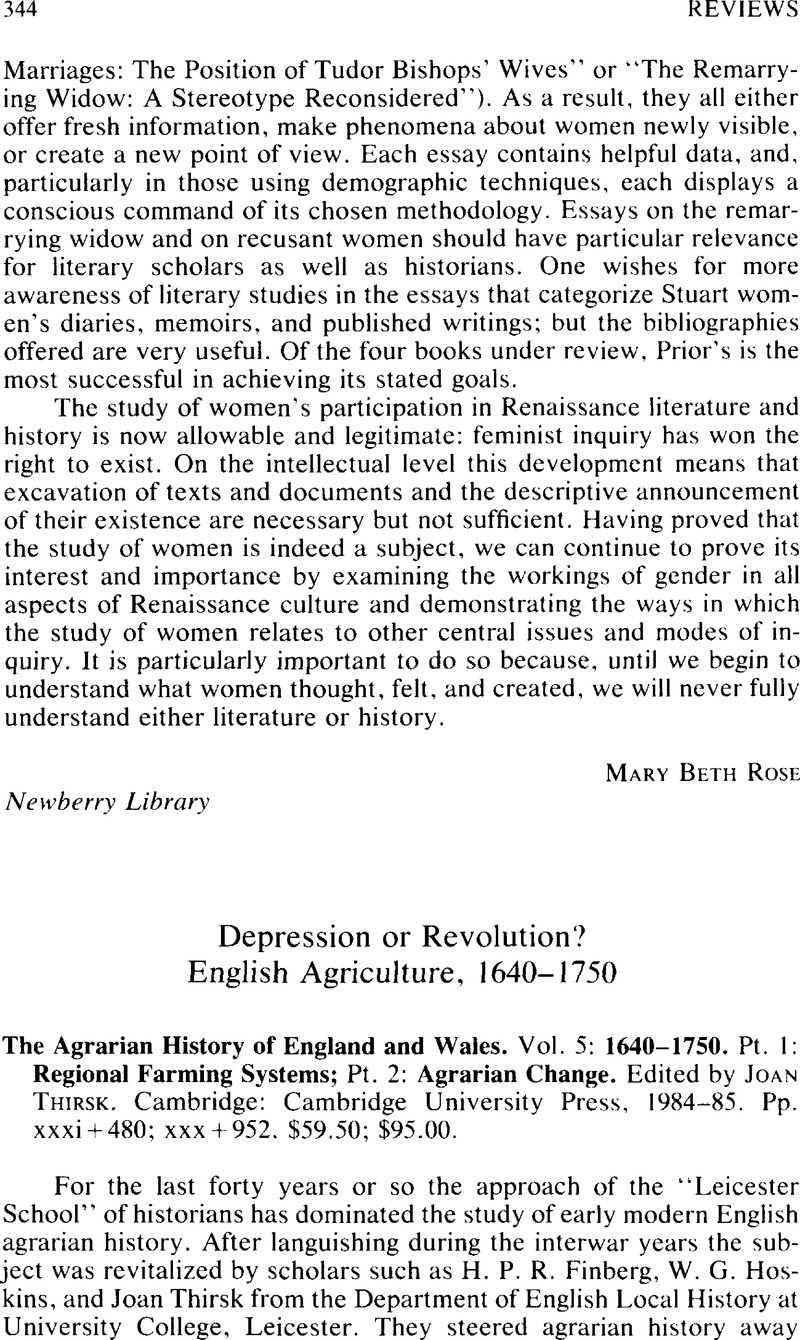Article contents
Depression or Revolution? English Agriculture, 1640–1750 - The Agrarian History of England and Wales. Vol. 5: 1640–1750. Pt. 1: Regional Farming Systems; Pt. 2: Agrarian Change. Edited by Joan Thirsk. Cambridge: Cambridge University Press, 1984–1985. Pp. xxxi + 480; xxx + 952. $59.50; $95.00.
Published online by Cambridge University Press: 10 January 2014
Abstract

- Type
- Reviews
- Information
- Copyright
- Copyright © North American Conference of British Studies 1986
References
1 Finberg, H. P. R., “An Agrarian History of England,” Agricultural History Review 4 (1956): 2–3Google Scholar; Thirsk, Joan, ed., The Agrarian History of England and Wales, vol. 4, 1500–1640 (Cambridge, 1967)Google Scholar.
2 These ideas are reflected in much of her writing, conveniently available in Thirsk, Joan, Rural Economy of England: Collected Essays (London, 1984)Google Scholar.
3 McGregor, O. R., “Introduction Part Two: After 1815,” in English Farming Past and Present, by Ernle, Lord, 6th ed. (London, 1961), p. cxiiGoogle Scholar.
4 This point is made in a review of vol. 4 of The Agrarian History of England and Wales (Jones, E. L., “The Condition of English Agriculture, 1500–1640,” Economic History Review, 2d ser., 21 [1968]: 615–16Google Scholar). For an example of the derivation of farm types, see Overton, Mark, “Agricultural Regions in Early Modern England: An Example from East Anglia,” Department of Geography Seminar Paper 42 (University of Newcastle upon Tyne, 1985)Google Scholar.
5 For a review of a nineteenth-century model of rural society, see Banks, S. J., “Open and Close Parishes in Nineteenth-Century England” (Ph.D. thesis, University of Reading, 1982)Google Scholar. Early modern studies that emphasize the village as the unit of analysis include Spufford, M., Contrasting Communities: English Villagers in the Sixteenth and Seventeenth Centuries (Cambridge, 1974)CrossRefGoogle Scholar; and Levine, D., Family Formation in an Age of Nascent Capitalism (New York, 1977)Google Scholar.
6 For an example of large-scale regional analysis, see Kussmaul, Ann, “Agrarian Change in Seventeenth-Century England: The Economic Historian as Paleontologist,” Journal of Economic History 45 (1985): 1–30CrossRefGoogle Scholar.
7 For such an analysis of the contemporary farming literature. see Tribe, K., Land, Labour and Economic Discourse (London, 1978), pp. 53–79Google Scholar.
8 More than half the twentieth-century works cited in his footnotes were published before 1960. A graph of the population of England appeared in Smith, R. M., “Population and Its Geography in England, 1500–1730,” in An Historical Geography of England and Wales, ed. Dodgshon, R. A. and Butlin, R. A. (New York, 1978), p. 207Google Scholar.
9 Overton, Mark, “The Diffusion of Agricultural Innovations in Early Modern England: Turnips and Clover in Norfolk and Suffolk, 1580–1740,” Transactions of the Institute of British Geographers, n.s., 10 (1985): 205–21CrossRefGoogle Scholar.
10 Wordie, J. R., “The Chronology of English Enclosure, 1500–1914,” Economic History Review, 2d ser., 36 (1983): 483–505CrossRefGoogle Scholar.
11 Some important recent contributions are Kussmaul, Ann, Servants in Husbandry in Early Modern England (Cambridge, 1981)CrossRefGoogle Scholar; Snell, K. D. M., Annals of the Labouring Poor: Social Change and Agrarian England, 1660–1900 (Cambridge, 1985)CrossRefGoogle Scholar; Spufford, Margaret, The Great Reclothing of Rural England (London, 1984)Google Scholar; and Charlesworth, Andrew, ed., An Atlas of Rural Protest, 1548–1900 (London, 1983)Google Scholar.
12 Wrigley, E. Anthony, “Urban Growth and Agricultural Change: England and the Continent in the Early Modern Period,” Journal of Interdisciplinary History 15 (1985): 683–728CrossRefGoogle Scholar.
13 Overton, Mark, “Estimating Crop Yields from Probate Inventories: An Example from East Anglia, 1585–1735,” Journal of Economic History 39 (1979): 363–78CrossRefGoogle Scholar; Turner, Michael, “Agricultural Productivity in England in the Eighteenth Century: Evidence from Crop Yields,” Economic History Review, 2d ser., 35 (1982): 489–510CrossRefGoogle Scholar; but see Overton, M., “Agricultural Productivity in Eighteenth-Century England: Some Further Speculations,” Economic History Review, 2d ser., 37 (1984): 244–51CrossRefGoogle Scholar; and the reply by Turner, Michael, “Agricultural Productivity in Eighteenth-Century England: Further Strains of Speculation,” Economic History Review, 2d ser., 37 (1984): 252–57CrossRefGoogle Scholar.
14 Crafts, N. F. R., “British Economic Growth, 1700–1831: A Review of the Evidence,” Economic History Review, 2d ser., 36 (1983): 177–99CrossRefGoogle Scholar, and “Income Elasticities of Demand and the Release of Labour by Agriculture during the British Industrial Revolution,” Journal of European Economic History 9 (1980): 153–168Google Scholar; Jackson, R. V., “Growth and Deceleration in English Agriculture, 1660–1790,” Economic History Review, 2d ser., 38 (1985): 333–51Google Scholar.
15 Clarkson, L. A., Protoindustrialization: The First Phase of Industrialization (Lodon, 1985)CrossRefGoogle Scholar. An interesting article not reprinted in Thirsk's Rural Economy of England (n. 2 above) is her “The Roots of Industrial England,” in Man Made the Land, ed. Baker, A. R. H. and Harley, J. B. (Newton Abbot, 1973), pp. 93–108Google Scholar.
16 Brenner's, R. “Agrarian Class Structure and Economic Development in Pre-Industrial Europe (Past and Present, no. 70 [1976], pp. 30–74)Google Scholar inaugurated the debate that is contained in Aston, T. H. and Philpin, C. H. E., eds., The Brenner Debate: Agrarian Class Structure and Economic Development in Pre-industrial Europe (Cambridge, 1985)CrossRefGoogle Scholar. For the application of a neo-Malthusian model, see Schofield, R. S., “The Impact of Scarcity and Plenty on Population Change in England, 1541–1871,” Journal of Interdisciplinary History 14 (1983): 265–91CrossRefGoogle Scholar.
17 Overton, M., “Agricultural Revolution? Development of the Agrarian Economy in Early Modern England,” in Explorations in Historical Geography, ed. Baker, A. R. H. and Gregory, D. J. (Cambridge, 1984), pp. 118–39Google Scholar.
18 Jones's contributions are collected in his Agriculture and the Industrial Revolution (Oxford, 1974)Google Scholar. John's, A. H. contributions begin with “The Course of Agricultural Change, 1660–1760” (in Studies in the Industrial Revolution, ed. Pressnell, L. S. [London, 1960], pp. 125–55)Google Scholar and culminate with “Agricultural Productivity and Economic Growth in England, 1700–1760” (Journal of Economic History 25 [1965]: 19–34)CrossRefGoogle Scholar.
19 Wallerstein, I., The Modern World-System II (London, 1980), p. 263Google Scholar.
20 Jones, pp. 4–5.
- 1
- Cited by




